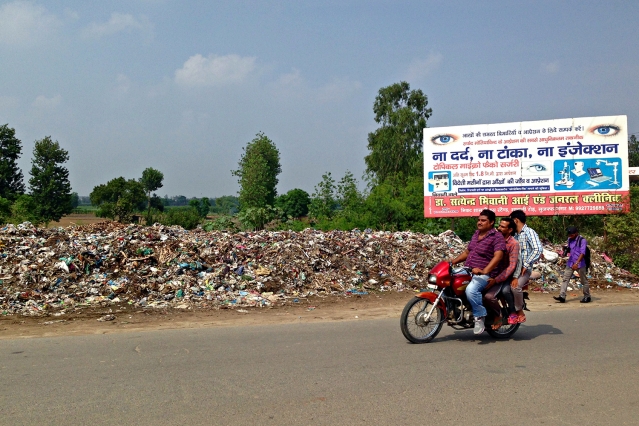
The massive Deonar dumping ground in Mumbai has become the most visible emblem of an increasingly serious nationwide problem for India: what to do with its trash.
Deonar’s towers of garbage are tall enough that there are concerns they could affect the flight patterns of airplanes coming and going from India’s financial capital. The dump has caught fire twice so far in 2016, enveloping the city in smoke and raising an outcry from locals. And Mumbai isn’t alone. Nearly every city in India faces waste management challenges that are only expected to grow along with rising population and affluence.
A team of researchers at MIT’s Materials Systems Laboratory and Tata Center for Technology and Design wants to help cities understand their waste streams and begin to manage them in ways that are socially, economically, and environmentally sustainable.
Led by Randolph Kirchain, principal research scientist in the Materials Processing Center, and Jeremy Gregory, research scientist in the Department of Civil and Environmental Engineering, the team is developing a decision-support tool to help Indian cities optimize the way they collect, transport, and treat household waste.
“Like many things in India, there’s no one-size-fits-all solution,” Gregory says. “Everyone interacts with the solid waste system, so everyone stands to gain from better management. But to do it right, you have to understand the cultural, socioeconomic, and technical context of a particular city.”
For example, every day in the north Indian city of Muzaffarnagar, a complex system goes into action, attempting to deal with the 120 tons of solid waste — glass, plastic, paper, food — generated by the city’s residents.
Hundreds of waste collectors fan out across the city pedaling tricycle carts, which they fill with the refuse from approximately 50,000 households before taking it away to be treated or dumped. Meanwhile, informal waste workers such as kabadiwalas (scrap collectors) salvage recyclables and other valuable materials, which they sell to make their living. Finally, waste that goes uncollected is often dumped by the roadside or in bodies of water.
Some variation of this largely ad hoc process occurs in dozens of cities across India, where solid waste management is a complex system of public, private, and informal players.
Throwing away value
The decision-support tool being created at MIT will use a variety of parameters to optimize a waste management system and recommend strategies tailored to a city’s needs, factoring in all the dynamics of a city like Muzaffarnagar.
But first, Gregory says, “We need to understand the waste composition and how that composition varies by socioeconomic class.”
Kirchain adds, “We anticipate higher waste generation in India not only because of population growth, but because of growing affluence. One motivator for us is to understand how waste might differ across income classes.”
They are using Muzaffarnagar as a pilot city, where they have conducted a “waste audit” of six neighborhoods at different socioeconomic levels.
“We collected waste door-to-door from 30 households in each of these neighborhoods over a span of eight weeks,” explains Dhivya Ravikumar, a Master’s student in the Technology and Policy Program and a fellow in the Tata Center. “We sorted the waste into different categories, which allowed us to quantify exactly what the composition was and how it varied by income.”
Perhaps their most exciting discovery was that roughly 60-70 percent of the total waste was organic — primarily food waste.
“As this organic waste is mixed with other waste streams, energy is spent separating the organic waste to extract value from it. What this means is that a lot of value is being lost,” Ravikumar says. “There’s a large potential for organic food waste that is not being tapped.”
Various methods exist for converting organic waste into valuable commodities; these methods include biogas production, composting, and pelletization. This creates the potential for cities and private companies to generate additional revenue while reducing the environmental stress of waste dumping. But to take advantage of it, different waste management strategies will be needed.
Suggesting what those strategies could be is where the MIT tool comes in.
“Maybe you need smaller treatment centers around the city, instead of one central treatment center,” says Ravikumar. “Maybe you need to implement effective municipal policies, or create incentives for people to segregate their organic waste.”
The MIT team is not advocating any particular technology. Rather, they want to recommend the most appropriate solution for a specific context, including those that are still in the exploratory stage.
“We want to add to our portfolio new technologies coming out of the Tata Center program,” Gregory says, citing a bioreactor being developed by Gregory Stephanopoulos, the Willard Henry Dow Professor in Chemical Engineering at MIT, and a torrefaction reactor being developed by Ahmed Ghoniem, the Ronald C. Crane (1972) Professor in Mechanical Engineering at MIT.
Designing systems that empower
Their next step is to scale up their audit from those six neighborhoods to the entirety of Muzaffarnagar. Ultimately, they want to identify the key parameters that will make the GIS-based tool applicable across different urban typologies.
“It’s not just about designing the system that costs the least,” Gregory says. “You can also design a waste system that encourages employment, social equality, or positive environmental impact.
“It’s important to remember that people make their livelihood from this system. There’s an instinct for people from Western countries to say, ‘We should have a Western-style system here,’ but we think that would be a mistake. You have to consider the impact on everyone involved, formally and informally.”
The team will return to Muzaffarnagar this summer to explore collection strategies, such as incentivizing households to segregate their food waste, and also to study the impact of municipal policies on waste generation in collaboration with local government and the Shri Ram Group of Colleges.